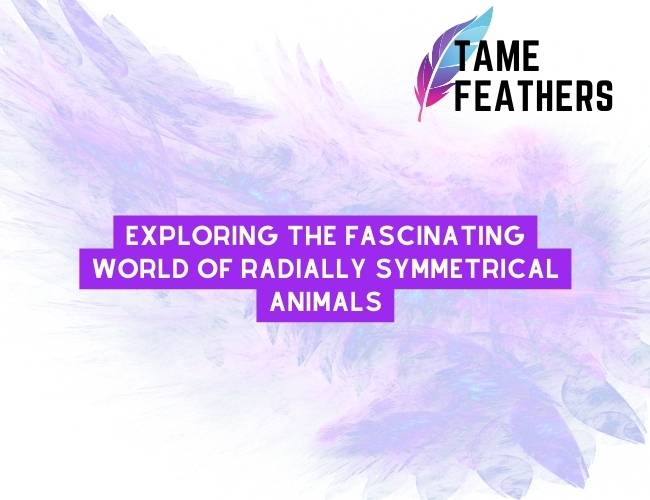Are you curious about the fascinating world of radially symmetrical animals? Have you been wanting to learn more about these creatures and the ways in which they differ from animals with bilateral symmetry? From jellyfish to starfish, I’ve been researching these amazing animals for quite some time, and I’m here to share my knowledge with you!
In this article, I’ll walk you through what makes these animals so special, the different species of radially symmetrical animals, and their unique characteristics. We’ll also explore how they’ve adapted to survive in their environments and the scientific research being done to protect them. By the end of this article, you’ll have a better understanding of why these creatures are so important and what makes them stand out from other animals. So let’s dive in and take a closer look at these unique creatures!
Table Of Contents
Add a header to begin generating the table of contents
What Are Radially Symmetrical Animals?
Radial symmetry is a term used to describe an organism that can be divided into equal halves by any longitudinal plane through its central axis. This means that the animal will have identical parts on all sides of its body, with no true left or right side. Unlike bilaterally symmetrical animals, which have distinct anterior and posterior ends, radially symmetrical animals do not display any clear division between their head and tail regions.
The Anatomy Of Radially Symmetrical Animals
Radially symmetrical animals typically exhibit a circular or cylindrical body structure with tentacle-like appendages radiating outwards from their central axis. These appendages are often used for feeding, movement or defense mechanisms. In some cases, the radial symmetry may also extend to internal organs such as digestive systems and reproductive structures.
Classifying Radially Symmetrical Animals
There are several phyla of organisms that exhibit radial symmetry including Echinodermata (sea urchins, starfish), Cnidaria (jellyfishes sea anemones) and Ctenophora (comb jellies). These phyla share many characteristics such as possessing stinging cells called nematocysts in cnidarians e.g jellyfish while echinoderms possess spines on their skin surface.
The Differences Between Radially Symmetrical and Bilaterally Symmetrical Animals
While both types of organisms can be found across various species within the animal kingdom, there are significant differences between them in terms of morphology and behavior. Bilateral symmetry allows for more complex movement patterns due to having distinct front-end orientation while radial symmetry results in limited mobility since they don’t have specific frontal orientation.
Characteristics Of Radially Symmetrical Animals
In addition to their unique anatomical features, radially symmetrical animals also possess other characteristics that set them apart from other types of organisms including relatively simple nervous systems compared to bilaterians because they lack cephalization i.e concentration of nerve tissue at one end resulting in less organized neural pathways.
Common Types Of Radially SymmetricaL Animals
Marine Invertebrates: Sea Anemones, Starfishes ,Jelly Fish And Urchins- these group comprises mostly aquatic creatures inhabiting marine environments where they display vibrant colors making them highly sought after aquarium pets
Cephalopods: Octopus Squid Cuttle fish Nautilus – these belong class molluscs known for their intelligence capabilities such as problem-solving skills like opening jars designed specifically against octopuses
Comb Jellies – these groups belong class ctenophores comprising mostly small gelatinous planktonic predators with eight comb-like rows running along each side enabling propulsion.
The Role Of Radial Symmetry In Ecosystems
Radial symmetric organisms play critical roles in ecosystems worldwide serving as food sources for larger predatory species thus helping maintain healthy populations among those higher up on the food chain . They also facilitate nutrient recycling processes through excretion functions aiding nutrient cycling processes supporting primary producers e.g plants producing oxygen via photosynthesis leading towards atmospheric balance.
Benefits Of Studying Radial-Symmetry Organisms
Studying radialsymmetric creatures provides insights into diverse biological phenomena studying how adaptations arise due to environmental pressures leading towards better understanding evolution trends observed over time decades centuries millennial etcetera; It helps us create new modes thinking about our world viewing things differently than before improving scientific methodologies applied research projects around wildlife conservation efforts working together achieving conservation goals sustainably managing resources available now future generations benefitting long-term welfare humanity overall
. Additionally, studying radial symmetry in animals can also provide insights into genetic and developmental processes that shape the diversity of life on Earth. This knowledge can be applied to various fields such as medicine, biotechnology, and agriculture.
In conclusion, radial symmetry is a unique feature found in many organisms across different phyla within the animal kingdom. These creatures have distinct anatomical features and play crucial roles in maintaining healthy ecosystems worldwide. Studying these organisms provides valuable insights into biological phenomena that shape life on Earth and has practical applications for improving human welfare through diverse fields of research.
